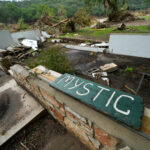Three years after Hurricane Katrina slammed into the Louisiana coast, New Orleans residents Wednesday again faced the prospect of an evacuation as Tropical Storm Gustav loomed.
Not since Katrina and Hurricane Rita, which followed in its wake, have residents faced government orders to evacuate their homes and businesses. Many are still struggling to rebuild their lives in a city famed for its jazz clubs and Mardi Gras festival.
On Wednesday, two days before the third anniversary of Katrina’s landfall on Aug. 29, 2005, Gustav drifted away from Haiti and the Dominican Republic after killing 23 people. It could hit the U.S. Gulf Coast around Monday.
The storm was expected to strengthen to a hurricane over the Gulf’s warm waters, and U.S. landfall could be anywhere from the Florida Panhandle to Texas.
But Gustav’s most likely track is directly toward New Orleans.
Louisiana Gov. Bobby Jindal put New Orleans residents on alert, declaring a state of emergency and saying evacuations could begin as early as Friday, just before the Labor Day holiday weekend.
“Our state is better prepared than it has been before to respond to a major disaster,” Jindal said. “But I want to emphasize that our citizens have a personal responsibility.”
Storm levees broke under the onslaught of Katrina in 2005, flooding 80 percent of New Orleans and killing almost 1,500 people in the city and along the Gulf coast. The hurricane caused at least $80 billion in wind and flood damage.
City officials said New Orleans Mayor Ray Nagin would order an evacuation if Gustav looked likely to come ashore with wind speeds over 111 miles per hour — a Category 3 hurricane or higher on the 5-step Saffir-Simpson scale.
“It’s still too early to tell exactly what it’s going to do,” city emergency preparedness director Jerry Sneed said.
Nagin, the city’s public face during Katrina and Rita, cut short his trip to the Democratic National Convention in Denver to return home.
THEY ASSUME RESPONSIBILITY
During Katrina and Rita, many city residents ignored mandatory evacuation orders and remained to guard their homes and businesses from looters.
Sneed said residents would not be physically forced to leave their homes during an evacuation order, which would be given about 30 hours before the storm comes ashore. At that time, all major roads would be rerouted to carry traffic away from New Orleans, Jindal said.
But they assume responsibility if they stay, Sneed said.
“If a tree comes through the roof and buries them underneath there, they’re going to be on their own,” Sneed said.
Sneed said he was confident that floodgates and pumping stations that failed during the 2005 storms would bear up.
“The citizens should not be worried about the flooding again,” he said.
Jindal activated the state’s catastrophic action team and declared a state of emergency, allowing him to activate the Louisiana National Guard.
The Republican governor, elected in October 2007, is hoping to avoid the heavy criticism that fell on his Democratic predecessor, Kathleen Blanco, for not reacting swiftly after Katrina.
Federal agencies and the New Orleans city government also faced the wrath of residents over their response to the disaster. President Bush himself was severely criticized for his role, including his initial decision to view the devastated city only from the air.
After Katrina, chaos broke out in New Orleans as stranded flood victims waited days for help. Many residents who fled the hurricane have not returned.
Jindal said that if the threat continued, the state could make 700 buses available for assisted evacuations Friday to carry about 35,000 people who need help due to medical or other conditions. Amtrak trains were standing by to move 7,000 elderly residents to safety, Sneed said.
Was this article valuable?
Here are more articles you may enjoy.

 J&J Talc Jury Awards $1.56 Billion to Asbestos Cancer Victim
J&J Talc Jury Awards $1.56 Billion to Asbestos Cancer Victim  Twice Injured Firefighter Loses Second Workers’ Compensation Claim
Twice Injured Firefighter Loses Second Workers’ Compensation Claim  Tesla Drivers Are Buying Escape Tools and Cars to Avoid Getting Trapped Inside
Tesla Drivers Are Buying Escape Tools and Cars to Avoid Getting Trapped Inside  Texas Camp’s Reopening Draws Outrage, but Some Families Want to Return
Texas Camp’s Reopening Draws Outrage, but Some Families Want to Return 